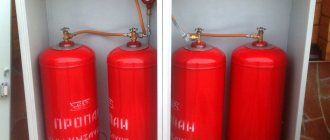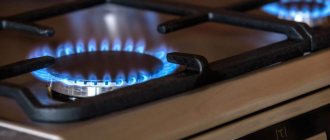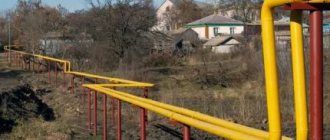- 1 What does GOST say about this?
- 2 Is it necessary to determine the gas consumption of a gas stove per hour? 2.1 Video - Gas supply, gearbox design
The need to install gas meters has increased in the context of widespread gasification. In turn, this need has presented homeowners with a new task - to learn how to carry out the correct calculations to select the appropriate model of metering device. And one of the most important points in the calculations is the consumption of a gas stove per hour, including the indicators of other equipment operating on gas. This is what we will discuss in today’s article.
What does GOST say about this?
Let us immediately make a reservation that we will not talk about the legal component of this issue, we will focus exclusively on the technical aspects. The technical characteristics of gas stoves are clearly regulated by GOST. The document says that the number of burners for the tiles can be different (2, 3 or 4). Moreover, each of them must provide the required combustion, which is resistant to air flows.
The burner power, in turn, can be:
- Regular (1,700 watts)
- High (2,600 watts)
- Reduced (600 watts).
On average, the power of one gas stove is about 10 kilowatts.
And you don’t need complex mathematical calculations to find out that the fuel consumption of one average burner is about 1.2 m3/hour. Although this parameter is necessarily indicated in the manufacturer’s instructions, be it natural gas or liquefied gas.
Note! If there are quite old tiles in your house, and the corresponding documents for them have long “disappeared somewhere,” then we recommend that you rely on average indicators.
Is it necessary to determine the gas consumption of a gas stove per hour?
First of all, you should definitely know this indicator in order to choose the right model and type of meter. Moreover, even the most minor miscalculations in this case sometimes lead to unexpected consequences. Speaking about the most common of them, first of all it is worth noting malfunctions in the operation of the measuring device. As a result, it will need to be replaced, and this is associated with complex installation processes associated with the alteration of gas pipes.
The accompanying documentation for the meter must indicate an index (it is designated by the letter G), which determines the power parameters. Essentially, the index demonstrates what total fuel consumption in the house is acceptable for the normal functioning of the device. Let's say you only have a stove that runs on gas. In this case, the flow rate per hour will range from 0.03 to 1.2 m3. Therefore, there is no point in buying and installing a meter that is designed for higher powers. One of the simplest models is quite enough.
Video - Gas supply, gearbox design
The situation changes dramatically when, along with a gas stove, which has low consumption, there is an additional boiler or water heater in the house. The indicators for this type of units are completely different. For example, the consumption of a gas water heater is significantly higher than that of a stove, even if it has four burners. As a result, the simplest accounting device mentioned above is clearly not enough here.
Note! In those houses where complex gas appliances operate, the minimum consumption is determined based on the indicators of the gas stove, while the maximum is determined in total.
If there are too many gas devices, this can lead to another problem - a large “gap” between the minimum/maximum values. Let's say your house has a stove, a boiler and a water heater, and they all consume blue fuel. The minimum in this case will be the minimum of the slab - 0.3 m3/hour, and the total maximum will be 7.1 m3/hour, and possibly more. A gas meter that can cover such a wide range simply does not exist in nature.
Features of prices in the presence of an individual metering device
Installing a meter is especially beneficial for consumers who consume small amounts of blue fuel. When choosing a gas meter, you need to take into account the model’s compliance with the requirements:
- characteristics of the gas mixture used;
- compliance with quality standards for metrological equipment;
- involving organizations with appropriate licenses and permits for installation;
- development of an individual gas utility project, suggesting the procedure and features of meter installation;
- sealing of the metering device by a representative of the controlling organization after installation;
- compliance with established verification periods and standard service life.
All necessary characteristics of the gas meter and requirements for its installation and operation are indicated in the passport documentation that accompanies the product from the manufacturer.
We recommend: How to correctly take readings from a gas meter
Only measuring devices included in the relevant list of the State Register are allowed for installation and operation.
Consumers need to take into account that the design of the device should allow compensation of indicators depending on ambient temperature conditions. If such a technical possibility is not provided for by the design of the product, increasing coefficients are applied, established in the regions in different months of the year and taking into account the climatic conditions of the area:
Coefficients for regions of the Russian Federation:
- January, February – 1.09,
- March, November, December – 1.07,
- October – 1.06,
- April – 1.04,
- September – 1.02,
- May, August – 1.01,
- June, July – 1.00.
Tariffs are set separately by region, differing depending on the volume of fuel consumption - if the consumer fits into the allocated limit, payment is set at the minimum rate, otherwise the amount increases significantly.
The consumer records the consumption of cubic meters of gas on a monthly basis, reporting data to the gas supply company. Payment is made according to the actual volumes of gas fuel used.
The consumer is responsible for providing information about gas meter readings no later than the 26th of the current month. Otherwise, if the utility does not receive the required information during the quarter, bills are issued at the average monthly consumption for the last year. Further, to present the amount for payment, they are guided by the standards.
One counter or several?
So what to do in this case? The best option is to install several accounting devices at once. The smallest of them - with a power rating of 1.6-2.5 - is placed on the stove; the other - more than 4 - for devices that consume natural gas in large quantities. This will help determine the gas consumption of a gas stove per hour. It is impossible not to mention the legal component here. For example, if two meters are installed, then there should also be two personal accounts for paying for gas supply services. And the payment for installation work will, in turn, double.
Things are completely different if there is a boiler with two circuits in the living space. And if in the case described above it is impossible to use the stove, heater and boiler at the same time, then here the heater and boiler cannot work at the same time due to the common burner. In this regard, the minimum will be determined both by the properties of the stove and by the parameters of the double-circuit boiler. And the gap between these indicators will not be as large as in the previous case, which means it will be much easier for you to choose the appropriate meter model.
How to calculate gas consumption for heating a house
Previously, we talked about how gas consumption for heating is calculated. We advise you to read this article
Finally, you should know everything related to calculations and features of choosing a metering device in order to save gas as much as possible. So, if there is no need for daily cooking of large quantities of food for the whole family, then a four-burner stove will most likely not be needed; as a result, the gas meter will be less powerful and cheaper.
Mains gas for heating needs
If a highly efficient condenser boiler is installed, the minimum specific heat value for “blue fuel” category G 20 is 37.78 MJ/cu. meter.
You can order a calculation of the heat losses of a residential building in order to create an “accounting” of seasonal costs and clarify for yourself whether there is a need to do insulation from a design organization
V=Q / (Hi x efficiency)
- V is the desired value that determines the gas consumption for generating thermal energy, measured in cubic meters/hour;
- Q – the value of the calculated thermal power expended to heat the building and provide comfortable conditions, measured in W/h;
- Hi is the minimum value of specific heat during fuel combustion;
- Efficiency is the efficiency of the boiler.
The efficiency of a boiler generator shows the efficiency of using the thermal energy generated during combustion of the gas mixture, which is directly spent on heating the coolant. It is a passport value.
In the passports of modern boiler units, the coefficient is indicated by two parameters: by higher and lower calorific value. Both values are written through the fractional line “Hs/Hi”, for example: 95/87%. To obtain the most reliable calculation, take as a basis the value specified in the “Hi” mode.
The lowest value of the specific heat of combustion of gas is a tabular value, the parameters of which correspond to the accepted standards DIN EN 437
The “Hs” value indicated in the table determines the highest heat value of gas combustion. It is indicated in the table for the reason that the water vapor released during gas combustion is also capable of converting latent thermal energy. If you use this thermal energy wisely, you can increase the total return on the consumed fuel.
The operation of new generation boilers – condenser units – is based on this principle. In them, due to the conversion of steam into an aggregate liquid state, an additional 10% of heat is generated.
In addition to G20 gas, an analogue of the second group, G 25, can also be used for domestic purposes. G 20 gas is extracted from Siberian deposits, and G25 is supplied from Turkmenistan and the Volga region. The difference between them is that G25 emits 15% less heat when burned.
Gas grade G25 is characterized by an increased percentage of nitrogen, due to which its energy potential is 15% lower than its natural analogue G20
You can find out what type of gas “flows” in the pipeline from the gas supply company in your region.
READ MORE: Maintenance and repair of gas boilers
We propose to consider an example of calculating gas consumption for heating a country cottage, the initial data of which has the following parameters:
- The area of the premises reaches 100 square meters. meters;
- recommended heat unit power – 10 kW;
- The boiler efficiency reaches 95%.
To simplify the calculation, joules are converted to another unit of measurement - kilowatts. So, provided that 1 kW = 3.6 MJ, the calorific value of G 20 gas will be 34.02/3.6 = 9.45 kW.
It is also worth considering that the recommended power of the heat generator, indicated as 10 kW, will only be required to heat rooms under the most unfavorable conditions. In fact, throughout the entire heating season, the number of such unfavorable days will be counted in single units.
With a well-thought-out and equipped heating system, the installed boiler unit will definitely not work around the clock
On the remaining days of the cold season, significantly less power is used to heat the building. Therefore, to obtain correct calculations, as well as to determine the average, and not the peak, consumption of “blue fuel”, the boiler power readings are not 10 kW, but “half” 5 kW.
Substituting the obtained data into the formula, perform the calculations: V = 5/(9.45 x 0.95). It turns out that to heat a cottage with an area of 100 square meters, the gas consumption is 0.557 cubic meters per hour.
Having clarified the tariffs for paying for one cubic meter of “blue fuel”, it will not be difficult to calculate material costs for the entire heating period
Based on the data obtained through simple calculations, it is not difficult to calculate gas consumption for the entire heating season, which in mid-latitude regions lasts about 7 months:
- For a day it is 0.557 x 24 = 13.37 m3.
- For a month 13.37 x 30 = 401.1 m3.
- For a heating season lasting 7 months 401.1 x 7 = 2807.4 m3.
Knowing the price of one cubic meter of “blue fuel”, it will not be difficult to plan both monthly expenses and “accounting” for the entire functioning of the heating system.
Rules for determining flow
As if summing up the previous section, let us briefly consider how to correctly determine gas consumption. The average gas stove, which is equipped with 4 burners, consumes from 1.2 m3/hour to 2.5 m3/hour of gas. Therefore, if you have a pair of such stoves, the volume of fuel consumed will increase to at least 2.5 m3/hour. And in order to specifically determine exactly how much will be consumed during operation, you need to look at the technical data sheet of the device.
And in order to choose the right gas meter, use the markings on its body indicating its throughput. But if you do not have the desire or opportunity to carry out these calculations, you can rely on the standards in force today:
- if the house only has a 4-burner gas stove, then the power of the meter should be 1.6;
- if there is such a stove, but in addition to it there is also a column, then this indicator should be 2.5.
Features of installation of the accounting device
Installation of the meter must be carried out exclusively by specialists with appropriate qualifications; compliance with the required installation standards and requirements is mandatory. As for the cost of installation work, it depends on a number of individual features, including the specific model of the device, the location of gas pipelines and gas-powered equipment.
Some tips for saving gas
- If possible, you should try not to cook dishes that have a small volume in the oven of a gas stove so often. This is explained by the fact that it is much more economical to cook two or three potatoes in the microwave than to do it using gas.
- It is also necessary to follow one important rule: select for cooking the burner whose power is intended for a specific dish. After boiling, you should always reduce the heat by at least half. Do not forget that the maximum temperature of the flame is located precisely at the tips of its tongues, and therefore it is necessary not to allow the burning gas to “touch” the container with the dish.
- Finally, it is advisable to purchase an economical model of shower head and not completely fill the bathtub with hot water (if this water is heated with gas, then it is generally advisable to use the shower more often).
If you follow the tips below, you can save some more on your utility bills.
Summing up
For any user, knowledge of its technical characteristics is mandatory. And if you calculate in advance the gas consumption of a gas stove per hour (this can also include a boiler or gas boiler), then you will save yourself from the dubious pleasure of being surprised by utility bills. Moreover, this information is extremely important when creating a residential gasification project, and it will not be possible to install meters without it. We will also repeat once again that all the necessary data can be found either in the technical documentation for the equipment, or you can use average indicators for calculations, which are regulated by standards.
Mains gas for heating needs
The use of gas as an energy carrier for the operation of the heating system is advantageous from all sides. First of all, they are attracted by the quite affordable tariffs for “blue fuel” - they cannot be compared with the seemingly more convenient and safe electric one. In terms of cost, only available types of solid fuel can compete, for example, if there are no special problems with the procurement or purchase of firewood.
In a word, if it is possible to choose this particular method of heating your home, then there is hardly any doubt about the advisability of installing a gas boiler.
In terms of efficiency and ease of use, gas heating equipment currently has no real rivals.
It is clear that when choosing a boiler, one of the key criteria is always its thermal power, that is, the ability to generate a certain amount of thermal energy. To put it simply, the purchased equipment, according to its technical parameters, must ensure the maintenance of comfortable living conditions in any, even the most unfavorable conditions.
This indicator is most often indicated in kilowatts, and, of course, is reflected in the cost of the boiler, its dimensions, and gas consumption. This means that the task when choosing is to purchase a model that fully meets the needs, but, at the same time, does not have unreasonably inflated characteristics - this is both disadvantageous for the owners and not very useful for the equipment itself.
When choosing any heating equipment, it is very important to find the “golden mean” - so that there is enough power, but at the same time - without completely unjustified overestimation
It is important to understand one more point correctly. This is that the specified nameplate power of a gas boiler always shows its maximum energy potential. With the right approach, it should, of course, slightly exceed the calculated data for the required heat input for a particular house. In this way, the same operational reserve is laid down, which may someday be needed under the most unfavorable conditions, for example, during extreme cold, unusual for the area of residence.
Will this capacity be fully utilized? – it’s quite possible that not. But its supply does not look excessive.
Why is all this explained in such detail? But only so that the reader becomes clear on one important point. It would be completely wrong to calculate the gas consumption of a specific heating system based solely on the equipment’s nameplate characteristics. Yes, as a rule, the technical documentation accompanying the heating unit indicates the energy consumption per unit of time (m³/hour), but this is again a largely theoretical value.
It is not advisable to use certified gas consumption values as a basis for calculations, since they will not show the real picture.
Often, passports indicate a consumption range - the boundaries of minimum and maximum consumption are indicated. But this probably will not be of great help in calculating real needs.
But it is still very useful to know gas consumption as close to reality as possible. This will help, firstly, in planning the family budget. Well, secondly, the possession of such information should, willingly or unwillingly, stimulate zealous owners to search for reserves of energy savings - perhaps it is worth taking certain steps to reduce consumption to the possible minimum.
So, the starting point for determining gas consumption for heating needs should still be the thermal power that is required for these purposes. Let's start our calculations with it.
If you look through the mass of publications on this topic posted on the Internet, you will most often find recommendations to calculate the required power based on the area of the heated premises. Moreover, for this a constant is given: 100 watts per 1 square meter of area (or 1 kW per 10 m²).
Comfortable? - undoubtedly! Without any calculations, without even using a piece of paper and a pencil, you perform simple arithmetic operations in your head, for example, for a house with an area of 100 “squares” you need at least a 10-watt boiler.
Well, what about the accuracy of such calculations? Alas, in this matter everything is not so good...
Taking the axiom that 100 W of heat is required for every meter of area as a basis for calculating heating power is not a completely serious approach.
Judge for yourself.
For example, will the thermal energy requirements of premises of the same area, say, in the Krasnodar Territory or regions of the Server Urals be equivalent? Is there a difference between a room bordering on heated premises, that is, having only one external wall, and a corner one, and also facing the windward north side?
So, there is no doubt that the required amount of thermal energy for heating a room is influenced not only by its area - it is necessary to take into account a number of factors related to the characteristics of the region and the specific location of the building, and the specifics of a particular room. It is clear that rooms within even the same house can have significant differences.
READ MORE: Lemax gas boiler does not turn on - possible problems and ways to solve them
Each room may have individual characteristics, so it is advisable to carry out calculations for the rooms separately, and at the end - to summarize the total
The proposed calculation algorithm does not claim to be a professional calculation, but has a sufficient degree of accuracy, proven by practice. To make the task extremely simple for our readers, we suggest using the online calculator below, the program of which has already included all the necessary dependencies and correction factors. For greater clarity, brief instructions on how to perform the calculations will be provided in the text block below the calculator.
Go to calculations
So, we will count for each room separately in approximately this sequence
- We start with the area of the room. And we will still take the same 100 W per square meter as the initial value, but many correction factors will be introduced as the calculation progresses. In the input field (using the slider) you must indicate the area of the room, in square meters.
- Of course, the required amount of energy is influenced by the volume of the room - for standard ceilings of 2.7 m and for high ceilings of 3.5 ÷ 4 m, the final values will differ. Therefore, the calculation program will introduce a correction for the height of the ceiling - you must select it from the proposed drop-down list.
- The number of walls in the room that are in direct contact with the street is of great importance. Therefore, the next point is to indicate the number of external walls: options are offered from “0” to “3” - each value will have its own correction factor.
- Even on a very frosty, but clear day, the sun can affect the microclimate in the room - the amount of heat loss is reduced, direct rays penetrating the windows sensitively heat the room. But this is typical only for walls facing south. As the next data entry point, indicate the approximate location of the external wall of the room - and the program will make the necessary adjustments.
“Frost and Sun – a wonderful day...” - it really is! The sun's rays, even in winter, are quite capable of influencing the microclimate in a room facing south
- Many houses, both country and urban, are located in such a way that the outer wall of the room is windward most of the winter. If the owners know the direction of the prevailing winter wind rose, then this circumstance can be taken into account in the calculations. It is clear that the windward wall will always cool more strongly - and the calculation program calculates the corresponding correction factor. If there is no such information, then you can skip this point - but in this case, the calculation will be carried out for the most unfavorable location.
If the prevailing direction of winter winds is known, then this circumstance can be taken into account in the calculations
- The next parameter will adjust for the climatic specifics of your region of residence. We are talking about temperature indicators that are typical in a given area for the coldest ten days of winter. It is important that we are talking specifically about those values that are the norm, that is, they are not included in the category of those abnormal frosts that every few years, no, no, and even “visit” any region, and then, due to their atypicality, remain for a long time in memory.
It is necessary to indicate those indicators of minimum winter temperatures that are the norm for a given region
- The level of heat loss is directly related to the degree of thermal insulation of the walls. In the next data entry field, you must evaluate it by choosing one of three options. At the same time, a wall can be considered fully insulated only if thermal insulation work has been carried out in full, based on the results of thermal engineering calculations.










